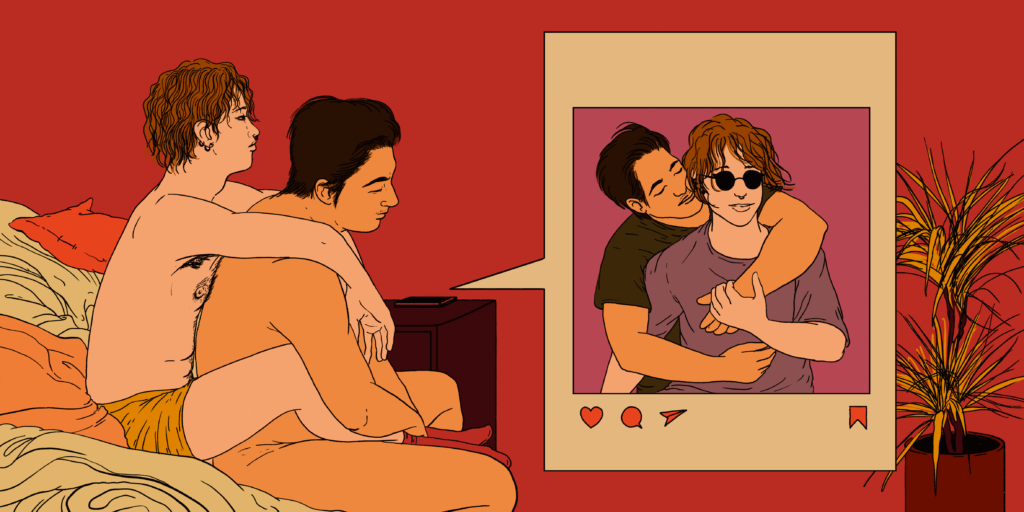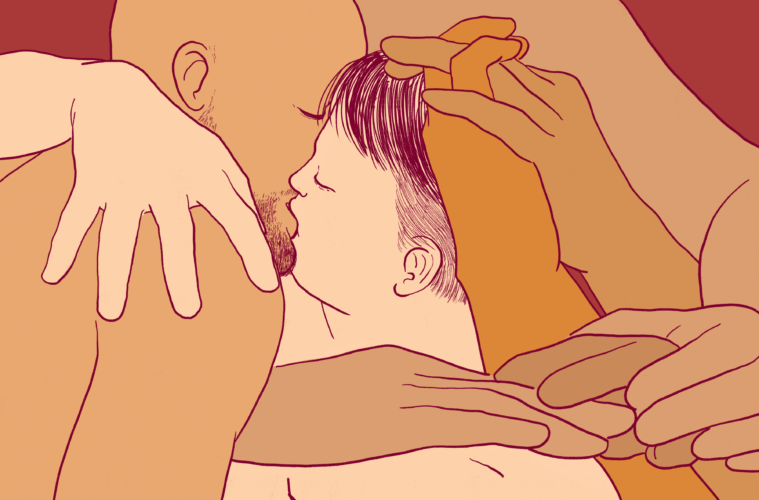Words by Madeeha Kleenex*
Translated by M.K.
Illustrations by Merieme Mesfioui
*The author uses a pseudonym.
In this article, we will discuss common stereotypes regarding sex roles within gay couples.
What do “Top” and “Bottom” mean?
Top and Bottom1 are specific words that determine sex roles or the “label” that gay men identify with. In gay sex, the Top is the pleasure giver, the person who penetrates, and/or the person who receives oral sex. The Bottom is the pleasure receiver, the person who gets penetrated, and/or the person who performs oral sex.
Why do some individuals ask the person they are newly dating about how they label themselves?
One of the first questions gay men ask when getting to know each other on a sexual level is, “how do you label yourself?”. The answer to this question informs the sexual practices between two partners in this relationship, and the dynamic of the bed they will be sharing soon enough. Although this question has purely sexual connotations and refers to sex roles, the answer suggests something much deeper. The answer can reflect personal traits or behaviors the partner may expect from a relationship beyond sex roles, and can hint at something parallel to a partner’s gender.2
Are these sex roles limited to sex?
During sex, these roles are purely sexual. However, these roles are also covertly gendered. In the LGBTQ+ community, the Top is stereotypically known to be the tough, responsible, possessive, jealous partner. Some characteristics that have become associated with Tops are growing a beard and having ‘manly’ interests such as football or cars. Bottoms, on the other hand, are stereotyped as being the weak, spoiled, submissive, and disciplined partner. Traits associated with Bottoms are wearing makeup or colorful glamorous clothes or having fashion interests. The traits of the Top and Bottom have developed into stereotypes, such that some people feel comfortable choosing their roles while others are forced into them.
How did the Top/Bottom stereotypes originate?
The stereotypes of the patriarchal gender roles in heterosexual relationships were indirectly transferred to gay relationships, which became similarly hierarchical. In heterosexual relationships, the sex roles were divided along gender lines, such that “man” became the Top and pleasure giver, while “women” became the Bottom and pleasure receiver. We began to associate a similar dynamic in homosexual relationships, such that the Top assumes a leadership role and is the decision maker, and the Bottom follows along. Chores are also stereotypically divided, so cleaning and cooking are often considered the Bottom’s responsibility, and driving the car or taking care of finances are the Top’s.

Illustration by Merieme Mesfioui
Are roles in relationships fixed?
To put it simply, these roles are not fixed. Typical traits, behaviors, or roles in relationships are not fixed, because they are essentially social constructs that have developed over time in hegemonic culture, and they will continue to change and evolve. Moreover, the associations these stereotypes entail are not definite. It would not make sense to think that a man who is a Top does not have a fashion sense simply because he is a Top, or a Bottom cannot make a decision or take responsibility simply because they are a Bottom. At the end of the day, each person will choose the role suitable to them and engage in their relationship in the way that feels right, regardless of the stereotypes that are passed down from the heterosexual patriarchal relationships which have become “the standard” relationship dynamic that everyone must follow.
Can we break free of these roles? And how?
The roles that we play in relationships are not fixed or pre-determined. Relationships are everchanging, shifting in relation to circumstances and personal desires, feelings, and experiences. Liking glamorous colors or being athletic don’t necessarily correlate to a particular sex role. All we can do is be ourselves, see our partners as our equals, and cultivate enough self-awareness so we can choose the roles that suit us, whether they are sexual or social. This could allow us to break free from these chains without forcing ourselves or our partners to choose a stereotypical role that our patriarchal society has paved the way for us to choose.
Do all gay people fall into this Top/Bottom binary?
In this article, we have discussed Tops and Bottoms in gay relationships. However, there is a third type on this spectrum: the Vers (short for versatile) or Switch. These are the people who like to alternate these roles between themselves and their partners. Unfortunately, though, even the Verses get correlated with stereotypes that Tops and Bottoms create in the LGBTQ+ community. When having a conversation with a Vers, we commonly see that they are being limited to be either Tops or Bottoms, and the reality of how they identify themselves is often ignored. It is possible that this stems from gay men’s devotion towards stereotypes of their traits to be in parallel with the knowledge within the community that set heterosexual relationships as a standard for all relationships. The solution lies in respecting people who choose roles for themselves and those who do not, or else we would fall into the trap of creating a new standard in which we hold people accountable if they fulfill it or not.
- Top and Bottom are English words originally, spread in the fifties of the last century to define sexual and non-sexual roles for same-sex relationships based on the enjoyment of control, submission, and role-playing, and in one way or another, they moved to our Arab world.
- Gender is defined as the attributes, stereotypes, and roles that we play in our lives in a way that society defines for us and through which it defines the characteristics of femininity and masculinity and their relationship to these roles.

